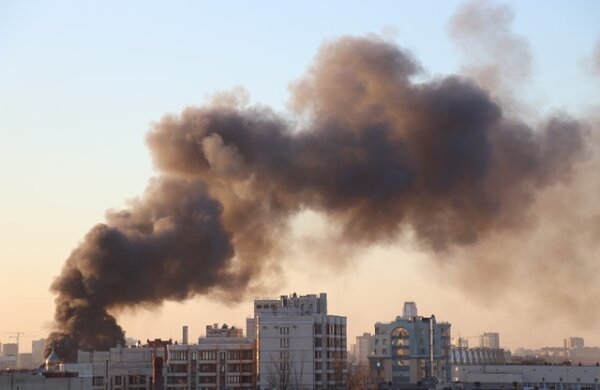Totally unexpected? Not!

This past year we’ve seen image after image of people emerging from the debris after tornados, trapped in long lines of cars to avoid a hurricane, escaping from a burning building in the midst of alarms and smoke. Were all these disasters totally unexpected? No!
Today, we are seeing more disaster images – people trying to escape sudden danger in Ukraine. And yet, that situation wasn’t totally unexpected, either. Let’s take a look.
The first images I saw yesterday were of Ukrainians who had rushed into underground subway stations to avoid explosions.
They were jammed in but seemed warm enough, and calm. Still, I didn’t see any supplies that would keep them comfortable for hours. Did you have the same questions I do?
- Do they have anything to eat?
- What about water?
- What about babies with no formula?
- How were hundreds of people able to use the toilet?
- Did they have any idea of what was going on above ground?
Today, the next day, the danger is no longer totally unexpected. People are taking action to protect themselves.
Today the news shows people fleeing Ukraine for neighboring countries. Some are walking across the border, abandoning household and pets “just to get somewhere safe!” Some are running out of gas in long lines of cars stretched across the countryside. Others, deeper inland in Ukraine, are crowding onto train station platforms, hoping to get a place on an outbound train.
Today, most of these people have a suitcase or backpack. But what about their future?
- How long will it take for them to get across the border?
- What will happen when they arrive?
- Where will they go? Or where will they end up?
- What about family members who have gotten separated?
I have questions about the people we don’t see in the news.
Those left behind. Those who are unable to walk or who have no money for trains or simply no place to go to. How are they faring now? What will happen to them in coming days?
Most of these questions remain unanswered as of right now. But the message for this Advisory is . . .
Emergencies aren’t always “natural disasters.” And they seldom are totally unexpected.
What’s going on today in Europe is a good reminder that there are many, many events that can result in emergencies. (In our business books we list 97 different threats!) But few of them should be totally unexpected.
It’s also a good idea to remember that many emergencies require the same or a very similar immediate response.
Of course, we can’t possibly be prepared for everything, but we can surely be prepared for an immediate response to whatever hits.
Here at Emergency Plan Guide we’ve examined that immediate response many times. A quick summary:
- The more we pay attention – to the weather, the news, political developments, etc. – the more likely we’ll have time to pack up some essentials in case things come apart. Having a Go-Bag already packed keeps you from being one of the victims that ends up stuffing some clothes into a pillowcase or plastic bag and having to make do with that!
- Having a family plan for re-connecting during or after an emergency can keep family members focused on immediate needs instead of spending valuable time worrying.
- Building a store of essential emergency supplies means that empty shelves in stores won’t terrify you. (We’ve heard that stores in Kyiv are already empty . . .) Supplies need to include non-perishable food, water, warm clothing, lighting, prescriptions, list of emergency contacts.
- If you have imagined and talked over how you might respond to expected emergencies – power outage, storm, riot, nuclear accident, hazardous chemical spill, whatever – you’ll have more confidence that you’ll be able to respond. Practicing with your basic emergency tools – radio, lantern, cookstove – will add more confidence. So will having a tank full of gas.
- Should you take some basic preparedness actions now?
Mindset makes all the difference to effective preparedness.
The more Joe and I are active in the world of emergency preparedness and response, the more importance we give to mindset or attitude! What a huge difference between a wild-eyed “What shall we do???” and a firm “We can handle this!”
Emergencies are part of life, to be expected. When they are anticipated, you’ll be far more able to get through them without them turning into a disaster.
Let’s treat the current situation in Ukraine as a valuable reminder of preparedness essentials.
Virginia
Your Emergency Plan Guide team
P.S. I know you know, but if this is a good time for a review, don’t forget our mini-series booklets. They’re laid out with questions and answers. Easy to read, easy to get ideas from. Here are a few that might be particularly helpful for this review:
Pre-Disaster Plan. Number 1 in our series because it deals with the toughest challenge of all – getting started on a plan. Major emphasis on coping with disaster when you or other family members are not at home. https://amzn.to/3aEswjk
Emergency Cash. How much cash do you need to shelter in place? To evacuate by car or train? Where to get cash/money and how to store it? https://amzn.to/2VNLm2X
Custom Go-Bags. Able to take you and your family through the first 3 days of an emergency – as long as the bags are customized AND ready to be grabbed. https://amzn.to/2vEmrow
There are 10 more titles in the series. You can see them all here.





